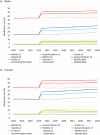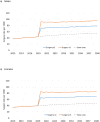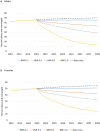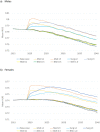A comparison of three strategies to reduce the burden of osteoarthritis: A population-based microsimulation study
- PMID: 34879102
- PMCID: PMC8654220
- DOI: 10.1371/journal.pone.0261017
A comparison of three strategies to reduce the burden of osteoarthritis: A population-based microsimulation study
Abstract
Objectives: The purpose of this study was to compare three strategies for reducing population health burden of osteoarthritis (OA): improved pharmacological treatment of OA-related pain, improved access to joint replacement surgery, and prevention of OA by reducing obesity and overweight.
Methods: We applied a validated computer microsimulation model of OA in Canada. The model simulated a Canadian-representative open population aged 20 years and older. Variables in the model included demographics, body mass index, OA diagnosis, OA treatment, mortality, and health-related quality of life. Model parameters were derived from analyses of national surveys, population-based administrative data, a hospital-based cohort study, and the literature. We compared 8 what-if intervention scenarios in terms of disability-adjusted life years (DALYs) relative to base-case, over a wide range of time horizons.
Results: Reductions in DALYs depended on the type of intervention, magnitude of the intervention, and the time horizon. Medical interventions (a targeted increase in the use of painkillers) tended to produce effects quickly and were, therefore, most effective over a short time horizon (a decade). Surgical interventions (increased access to joint replacement) were most effective over a medium time horizon (two decades or longer). Preventive interventions required a substantial change in BMI to generate a significant impact, but produced more reduction in DALYs than treatment strategies over a very long time horizon (several decades).
Conclusions: In this population-based modeling study we assessed the potential impact of three different burden reduction strategies in OA. Data generated by our model may help inform the implementation of strategies to reduce the burden of OA in Canada and elsewhere.
Conflict of interest statement
The authors have declared that no competing interests exist.
Figures






Similar articles
-
Disease burden of osteoarthritis of the knee and hip due to a high body mass index in China and the USA: 1990-2019 findings from the global burden of disease study 2019.BMC Musculoskelet Disord. 2022 Jan 17;23(1):63. doi: 10.1186/s12891-022-05027-z. BMC Musculoskelet Disord. 2022. PMID: 35039041 Free PMC article.
-
Effects of Reductions in Body Mass Index on the Future Osteoarthritis Burden in Canada: A Population-Based Microsimulation Study.Arthritis Care Res (Hoboken). 2016 Aug;68(8):1098-105. doi: 10.1002/acr.22796. Arthritis Care Res (Hoboken). 2016. PMID: 26606744 Free PMC article.
-
The projected burden of primary total knee and hip replacement for osteoarthritis in Australia to the year 2030.BMC Musculoskelet Disord. 2019 Feb 23;20(1):90. doi: 10.1186/s12891-019-2411-9. BMC Musculoskelet Disord. 2019. PMID: 30797228 Free PMC article.
-
Strategies for the prevention and management of osteoarthritis of the hip and knee.Best Pract Res Clin Rheumatol. 2007 Feb;21(1):59-76. doi: 10.1016/j.berh.2006.08.013. Best Pract Res Clin Rheumatol. 2007. PMID: 17350544 Review.
-
Addressing obesity in the management of knee and hip osteoarthritis - weighing in from an economic perspective.BMC Musculoskelet Disord. 2016 May 26;17:233. doi: 10.1186/s12891-016-1087-7. BMC Musculoskelet Disord. 2016. PMID: 27229924 Free PMC article. Review.
Cited by
-
Curcumin alleviates osteoarthritis in mice by suppressing osteoclastogenesis in subchondral bone via inhibiting NF-κB/JNK signaling pathway.PLoS One. 2024 Sep 5;19(9):e0309807. doi: 10.1371/journal.pone.0309807. eCollection 2024. PLoS One. 2024. PMID: 39236007 Free PMC article.
-
Net cost savings arising from patient completion of an active self-management program.PLoS One. 2023 Nov 15;18(11):e0293352. doi: 10.1371/journal.pone.0293352. eCollection 2023. PLoS One. 2023. PMID: 37967085 Free PMC article. Clinical Trial.
-
Risk factors associated with the occurrence of total knee arthroplasty in patients with knee osteoarthritis: a nested case-control study.Ther Adv Musculoskelet Dis. 2022 Apr 29;14:1759720X221091359. doi: 10.1177/1759720X221091359. eCollection 2022. Ther Adv Musculoskelet Dis. 2022. PMID: 35510169 Free PMC article.
References
-
- Kopec JA, Rahman MM, Berthelot J-M, Le Petit C, Aghajanian J, Sayre EC et al.. Descriptive epidemiology of osteoarthritis in British Columbia, Canada. J Rheumatol 2007;34(2):386–93 - PubMed
-
- Global Burden of Disease; Institute of Health Metrix and Evaluation. GBD Compare website. https://vizhub.healthdata.org/gbd-compare/. Accessed: October 7, 2020.
Publication types
MeSH terms
Associated data
Grants and funding
LinkOut - more resources
Full Text Sources
Medical

